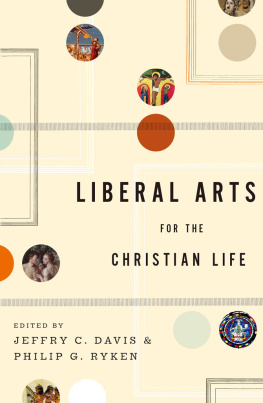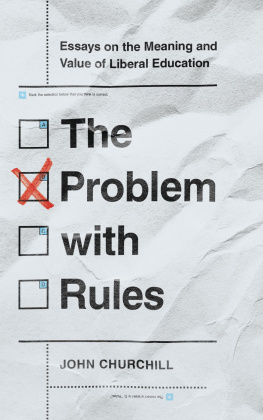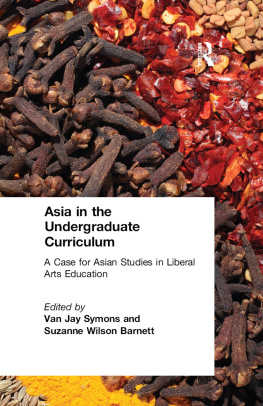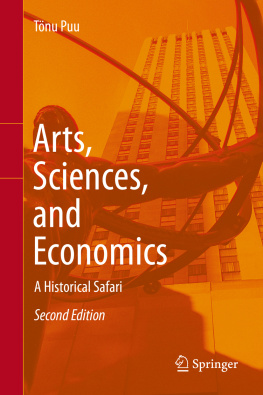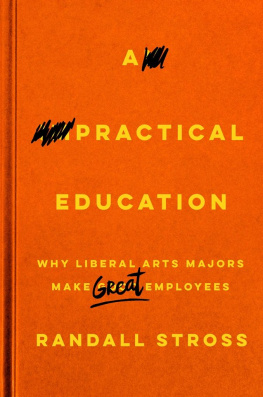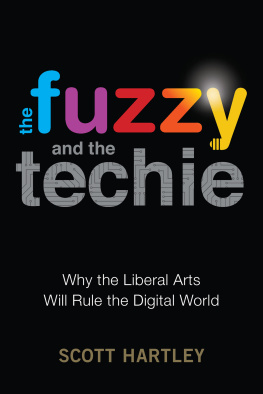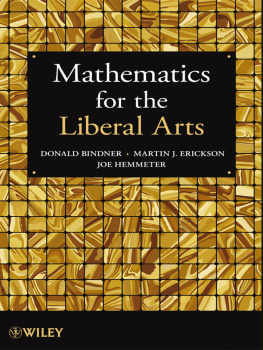Dan Rockmore - What Are the Arts and Sciences?: A Guide for the Curious
Here you can read online Dan Rockmore - What Are the Arts and Sciences?: A Guide for the Curious full text of the book (entire story) in english for free. Download pdf and epub, get meaning, cover and reviews about this ebook. year: 2017, publisher: Dartmouth College Press, genre: Politics. Description of the work, (preface) as well as reviews are available. Best literature library LitArk.com created for fans of good reading and offers a wide selection of genres:
Romance novel
Science fiction
Adventure
Detective
Science
History
Home and family
Prose
Art
Politics
Computer
Non-fiction
Religion
Business
Children
Humor
Choose a favorite category and find really read worthwhile books. Enjoy immersion in the world of imagination, feel the emotions of the characters or learn something new for yourself, make an fascinating discovery.
- Book:What Are the Arts and Sciences?: A Guide for the Curious
- Author:
- Publisher:Dartmouth College Press
- Genre:
- Year:2017
- Rating:5 / 5
- Favourites:Add to favourites
- Your mark:
- 100
- 1
- 2
- 3
- 4
- 5
What Are the Arts and Sciences?: A Guide for the Curious: summary, description and annotation
We offer to read an annotation, description, summary or preface (depends on what the author of the book "What Are the Arts and Sciences?: A Guide for the Curious" wrote himself). If you haven't found the necessary information about the book — write in the comments, we will try to find it.
An invaluable introduction to the arts and sciences for students, parents, and anyone curious about the nature of a liberal education
Dan Rockmore: author's other books
Who wrote What Are the Arts and Sciences?: A Guide for the Curious? Find out the surname, the name of the author of the book and a list of all author's works by series.
What Are the Arts and Sciences?: A Guide for the Curious — read online for free the complete book (whole text) full work
Below is the text of the book, divided by pages. System saving the place of the last page read, allows you to conveniently read the book "What Are the Arts and Sciences?: A Guide for the Curious" online for free, without having to search again every time where you left off. Put a bookmark, and you can go to the page where you finished reading at any time.
Font size:
Interval:
Bookmark:

Acknowledgments
Any project with the kind of breadth found here can only come about through the cooperation and contributions of many people. First and foremost, I want to thank my colleagues who contributed to this volume. Writing for a general audience poses all kinds of challenges, and I very much appreciate the generous spirit with which they took this on and their collaborative engagement with the editorial process. With any luck at all, the many friendships that were in place prior to beginning this project are still in place at its completion. Thanks also to the graphic artist Annelise Capossela, whose graceful and clever artwork adorns the chapters and cover.
This project came to UPNE with the help of Jeff Horrell, when he was Dean of Libraries at Dartmouth College. It would have never happened without Jeffs guidance and advice. His presence on the Dartmouth campus is already missed. Thanks to Dartmouth College Dean of Arts and Sciences Michael Mastanduno for his support in all ways and over many years and also to Richard Pult for having faith in the idea of this book and taking it on at UPNE.
My position as Director of the Neukom Institute for Computational Science has put me in the lucky position of coming into contact with a wide range of colleagues and projects on the Dartmouth campus. I gratefully acknowledge the generosity of former Dartmouth trustee Bill Neukom, which supports this vibrant intellectual nexus.
Many individuals came through with important advice and comments at various times and in various ways. Miles Blencowe would like to acknowledge the support of the National Science Foundation under Grant No. DMR-1507383. Sienna Craig dedicates her essay on Anthropology to Mr. Larry Goodman (Dartmouth 47), in gratitude for his unflinching support of the subject, and acknowledges her colleagues Sabrina Billings, Jesse Casana, and Jeremy deSilva, for their contributions to the chapter, and her father, Steve Craig, for his editorial feedback. Larry Polansky thanks Amy Beal and Dard Neuman for their comments (and the latter for a couple of choice phrases); he also thanks Adrian Chi for her comix Bite the Cactus in the punk magazine Razorcake for her retelling of this joke by her father. Christopher Snyder would like to give special thanks to James Feyrer and Douglas Irwin for their insights on macroeconomics and the Great Depression; he is also grateful to Patricia Anderson and Ada Cohen for insightful conversations, and to Henry Senkfor for able research assistance. Of course any lingering errors are the responsibilities of the authors. Special thanks to Sarunas Burdulis for some final image rendering. Id further like to give particular thanks to Katinka Matson and Steve Strogatz for their timely encouragements.
As with any thing that I manage to bring to completion, I can only do so with the support, love, and advisements of my wife Ellen. She has had to live with this project for as long as I have. I have so appreciated her thoughtful and insightful comments and calming advice at various critical moments.
This project was inspired by my children: Alex, Shayna, and Rachel. Their pure spirit of inquiry and wonder, and their constant asking What is... ? gave birth to this volume. Their eye-rolling whenever I begin an answer with Well, its complicated... helped to shape its form. Trying to see the world as they do and then trying to help them to understand it is one of the great joys of my life and an ongoing gift.
Finally, on behalf of all the contributors, Id like to thank family and friends and teachers and mentors who turned each of us on to a world of ideas and encouraged us to explore that world, each in our own way. We hope we can pay that favor forward. This book is dedicated to them.
Dan Rockmore

WHAT IS
African American Studies?
Derrick E. White
What if I told you that most of the great American histories were half-truths and some were outright lies? Many of the great American heroes fell far short of heroism. In the land of the free and home of the brave slavery and cowardice reigned. The American Revolution was not for all.
A central reason for the falsity of many great American histories has been the minimization or exclusion of African Americans (and other ethnic minorities) from this history. Many Americans can recall the deeds of the Founding Fathers in the countrys rebellion from British colonial rule. But few Americans remember that the first person killed in the 1770 Boston Massacre, which sparked the American Revolution, was Crispus Attucks, a man of African and Native American descent. The United States political, economic, and cultural expansion was not solely the province of white Americans, but was intertwined with the institutions of slavery, segregation, and racism. When one considers the legal impact of the civil rights movement, true American democracy is barely five decades old. America looked and looks different with African Americans at the center of the story.
The great abolitionist, statesman, and former slave Frederick Douglass declared in 1857, Unlike many academic disciplines that trace their origins to the early reaches of the Western tradition, African American Studies was born from the struggle for African American civil and human rights in the late 1960s.
The institutions of slavery and later Jim Crow segregation denied African Americans citizenship rights. Emboldened by the antifascism of World War II, however, black reformers were determined to make the United States live up to its all men are created equal credo. The civil rights movement of the 1950s and 1960s made African Americans equal, legally. Through a combination of the legal victories, protests, and political agitation African Americans slowly ended their unequal legal status.
However, many activists realized that each legal and political success revealed additional layers of American racial thinking and ideology. Frustrated by the slow pace of change, the stubbornness of the American public, and the revelation of the pervasiveness of American racism, both interpersonally and institutionally, some reformers advocated for Black Power, which was a declaration of black humanity in the face of white supremacy and a demand for African Americans to take immediate control of their lives and destiny. When civil rights and Black Power crusaders turned their attention to changing Americas racist culture, they knew that education, especially higher education, was a central issue.
The modern American university is the product of the convergence of several socioeconomic forces that were in play after the end of World War II. First, the US governments GI Bill (officially the Servicemens Readjustment Act of 1944) provided monies that allowed more than 2 million men to attend college or gain additional training. black student population. Finally, in the 1960s students of all races questioned college policies on dress, curfew, and politics. A generation of student activists, inspired by the civil rights movement, used the tactics of the movement to create new university practices.
The first African American Studies program emerged in this changing university context. Former civil rights activist Jimmy Garrett led the San Francisco State University Black Student Union, which joined with the Latin American Students Organization, the Filipino-American Student Organization, and El Renacimiento (an organization for Mexican students) to form the Third World Liberation Front in March 1968. The student leaders organized a series of protests, including a general strike from classes that in 1969 led to the first Black Studies Department and the first Ethnic Studies Department. By the early 1970s Black Studies departments and programs were appearing on campuses nationwide. The field has many names in the modern universityBlack Studies, African and African American Studies, African and African Diaspora Studies, Africana Studiesbut despite the variety of department and program titles, the goal is the same: the understanding of the black experience.
Next pageFont size:
Interval:
Bookmark:
Similar books «What Are the Arts and Sciences?: A Guide for the Curious»
Look at similar books to What Are the Arts and Sciences?: A Guide for the Curious. We have selected literature similar in name and meaning in the hope of providing readers with more options to find new, interesting, not yet read works.
Discussion, reviews of the book What Are the Arts and Sciences?: A Guide for the Curious and just readers' own opinions. Leave your comments, write what you think about the work, its meaning or the main characters. Specify what exactly you liked and what you didn't like, and why you think so.



